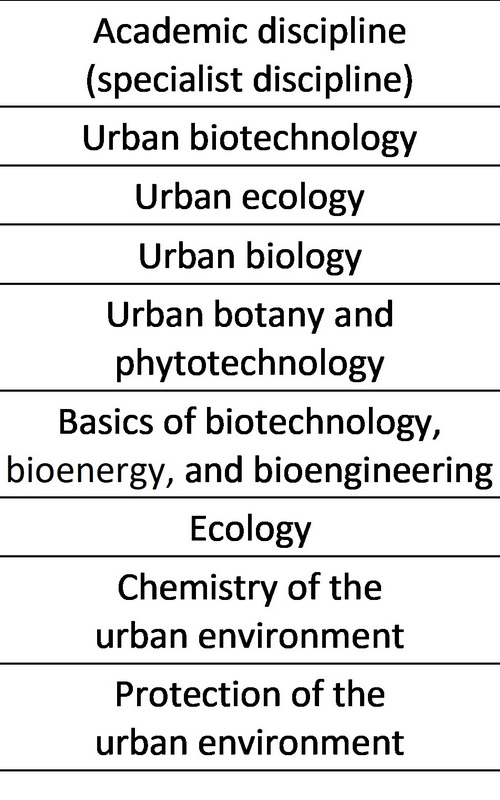New directions of biology and biotechnology in urban environmental sciences Letter to Editor
Main Article Content
Abstract
Living organisms and biological methods are widely used in recycling urban waste and improving the quality of the urban environment. Urban biology is a branch of biology that studies organisms living in cities. We propose using the new term "urban biotechnology". Urban biotechnology is the use of biotechnological methods to protect the urban environment and in urban energy. Urban biotechnology in the future may be included in the curriculum of the degree programs "Biotechnology", "Ecology " (profile "Applied Ecology"), "Chemistry" (profile " Сhemistry of the urban environment "), and Chemical Engineering (profile "Chemical and Biochemical Engineering "). We consider it important to train specialists in the fields of urban biology and urban biotechnology. We hope that urban biotechnology and urban biology will become independent disciplines in the future.
Article Details
Issue
Section

This work is licensed under a Creative Commons Attribution-NonCommercial-NoDerivatives 4.0 International License.
Authors who publish with this journal agree to the following terms:
Authors retain copyright and grant the journal right of first publication with the work simultaneously licensed under a Creative Commons Attribution License that allows others to share the work with an acknowledgement of the work's authorship and initial publication in this journal.
Authors grant to the Publisher the following rights to the manuscript, including any supplemental material, and any parts, extracts or elements thereof:
- the right to reproduce and distribute the Manuscript in printed form, including print-on-demand;
- the right to produce prepublications, reprints, and special editions of the Manuscript;
- the right to translate the Manuscript into other languages;
- the right to reproduce the Manuscript using photomechanical or similar means including, but not limited to photocopy, and the right to distribute these reproductions;
- the right to reproduce and distribute the Manuscript electronically or optically on any and all data carriers or storage media – especially in machine readable/digitalized form on data carriers such as hard drive, CD-Rom, DVD, Blu-ray Disc (BD), Mini-Disk, data tape – and the right to reproduce and distribute the Article via these data carriers;
- the right to store the Manuscript in databases, including online databases, and the right of transmission of the Manuscript in all technical systems and modes;
- the right to make the Manuscript available to the public or to closed user groups on individual demand, for use on monitors or other readers (including e-books), and in printable form for the user, either via the internet, other online services, or via internal or external networks.
How to Cite
References
Schultz B. Urban Biology: An Ecological Approach. The American Biology Teacher. 1960; 22(3): 147–152 https://doi.org/10.2307/4439282
Szulkin M, Munshi-South J, Charmantier A, eds. Urban Evolutionary Biology, Oxford and New York: Oxford University Press. 2020; 320. ISBN: 978-0-19-883684-1
Ramamurthy PC, Singh S, Kapoor D, Parihar P, Samuel J, Prasad R., Kumar A, Singh J. Microbial biotechnological approaches: renewable bioprocessing for the future energy systems. Microb Cell Fact. 2021; 20: 55. https://doi.org/10.1186/s12934-021-01547-w
Equiza MA, Calvo-Polanco M, Cirelli D, Señorans J, Wartenbe M, Saunders C, Zwiazek JJ. Long-term impact of road salt (NaCl) on soil and urban trees in Edmonton, Canada. Urban Forestry & Urban Greening. 2017; 21: 16-28. https://doi.org/10.1016/j.ufug.2016.11.003
Łuczak K, Czerniawska-Kusza I, Rosik-Dulewska C, Kusza G. Effect of NaCl road salt on the ionic composition of soils and Aesculus hippocastanum L. foliage and leaf damage intensity. Scientific Reports 2021; 11: 5309. https://doi.org/10.1038/s41598-021-84541-x
Tone Merete M, Jan-Willem K, Sanne B, van der Veen I, van Tol j. A review of applications of de-icing chemicals, representative for European countries. Deliverable 1.1 & 1.2. Tauw BV and the Norwegian University of Science and Technology. 2019;3.
Durickovic I. NaCl Material for Winter Maintenance and Its Environmental Effect. Salt in the Earth. Çinku MC, Karabulut S, eds., IntechOpen, 2019. https://doi.org/10.5772/intechopen.86907
Gladkov Evgeny A, Gladkova Olga V. Ecology and ecological - biotechnological aspects of the use of phytotechnologies. Moscow, Internauka. 2018. 102 p. ISBN 978-5-9500175-9-9
Gladkov Evgeny A, Gladkova Olga V. Cell Selection to Increase Deicing Reagents Resistance. Plant posters (P-2024). In Vitro Cell.Dev.Biol.-Animal 2021; 57: 48-61. https://doi.org/10.1007/s11626-021-00567-5
Gladkov Evgeny A, Gladkova Olga V. Ornamental plants adapted to urban ecosystem pollution: lawn grasses tolerating deicing reagents. Environmental Science and Pollution Research. 2021. https://doi.org/10.1007/s11356-021-16355-3





